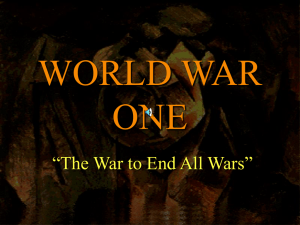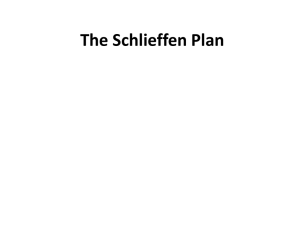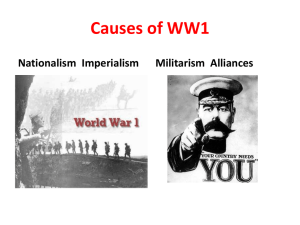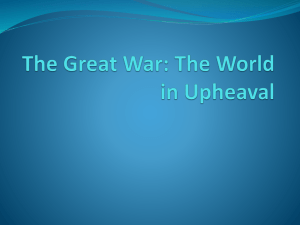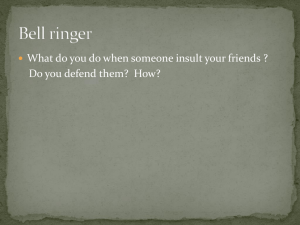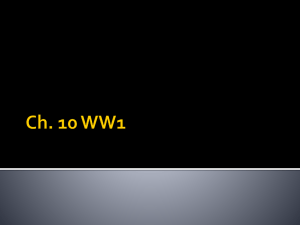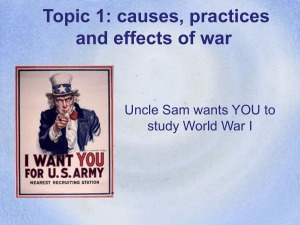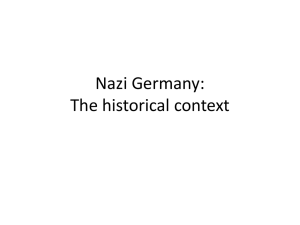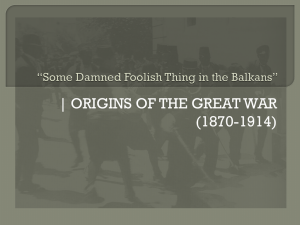Causes WWI Volusia 2012 - Preserving Our Nation Liberty
advertisement
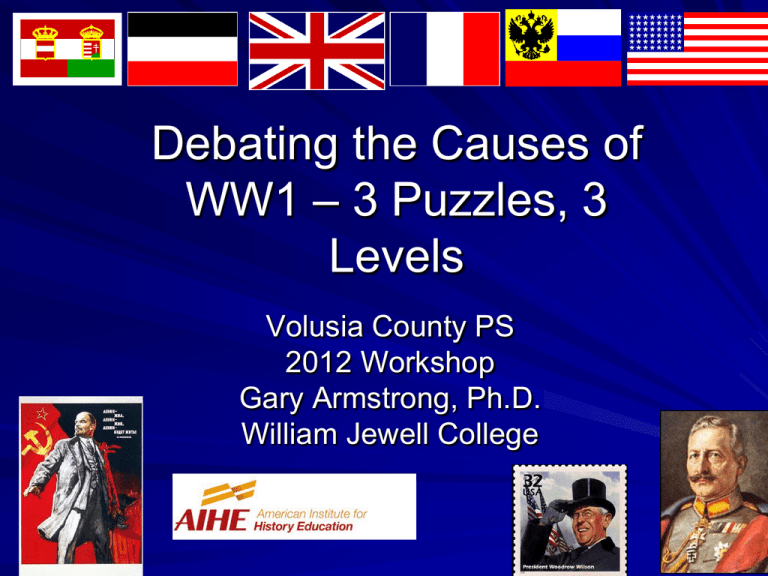
Debating the Causes of WW1 – 3 Puzzles, 3 Levels Volusia County PS 2012 Workshop Gary Armstrong, Ph.D. William Jewell College Causes of World War I A. B. C. D. E. F. Why 1914 Matters Incomplete Explanations A chauffeur’s wrong turn? A withered arm? Arms Race? Thinking War was Impossible? What Causes War? “3 Lenses” 3rd Lens: Rise of German Power Effects of German power: Rigid Alliances The Schlieffen Plan (& Forster Thesis) 2nd Lens: Domestic Crises Crises within Multinational Empires Fischer Thesis 1st Lens: Ideas Learning from 1914 – Competing Theories “Motives Theory” & “Accidental War” (& Levy’s Preference Scheme) “Spiral Theory” (& Turn the Army Around!) “Deterrence Theory” (& Britain as Missing Deterer) “Cult of the Offensive” (and Red Pants!) Great War Basics 1914-1918 Central Powers vs. Allies Dead: 9 Million military, 7 million civilian Firsts – – – – – Use of chemical weapons Mass attacks on civilians from air Genocide Immobile Front US in European War Widespread Collapse & Social Exhaustion New World Coming “The lamps are going out all over Europe. We shall not see them lit again in our lifetime.” Sir Edward Grey, British Foreign Secretary, 1905-1916 1862-1933 Niall Ferguson No persuasive evidence that Germany intended to “conquer the world” Germany’s September 1914 Program would have created German-dominated customs union That’s what we have today – 90 years later! The Chauffeur’s Fault Psychological Pathologies? Kaiser Wilhelm II 1959-1941 reign 1888-1918 Irrational Arms Race? The Naval Revolution HMS Dreadnought 1907 Dreadnought schema Naval Strength, 1914 Country Russia France Britain Germany A-H Personnel 54,000 68,000 209,000 Major Warships 4 10 29 79,000 16,000 17 3 Dreadnoughts 20 13 Confidence that Globalization won’t let it happen Economist, 10/97 War is not rational – Norman Angell Norman Angell 1872-1967 Nobel Peace Prize, 1933 Read Mill’s “Essay on Liberty” at age 12 Great Illusion, 1910 “…military and political power give a nation no commercial advantage, that it is an economic impossibility for one nation to seize or destroy the wealth of another, or for one nation to enrich itself by subjugating another.” Kenneth Waltz Emeritus Professor, UC Berkeley Most cited Neo-Realist Man, The State, & War (1959) Theory of International Politics (1979) Spread of Nuclear Weapons: Would More Be Better? (1995) What Causes War? Waltz & 3 Images First Image: Nature of man – Augustine, Reinhold Niebuhr – Waltz: Why This Doesn’t Work Second Image: Defects in Regimes – Woodrow Wilson, Lenin – The Liberal Democratic Peace – Waltz: Why This Doesn’t Work Third Image: Structure of World Politics – Anarchy & Security Dilemmas Rise of German Power Industrial Power (UK 1900 = 100) Country UK USA Germany France Russia A-H Italy Japan 1880 73.3 46.9 27.4 25.1 24.5 14 8.1 7.6 Source: Kennedy, Rise & Fall of the Great Powers 1900 [100] 127.8 71.2 36.8 47.5 25.6 13.6 13 1913 127.2 298.1 137.7 57.3 76.6 40.7 22.5 25.1 1928 135 533 214 74 72 -37 45 Rise of German Power: Military Manpower Country Russia France Germany UK A-H Italy USA 1880 791k 543k 426k 367k 246k 216k 34k Source: Kennedy, Rise & Fall of the Great Powers 1890 677k 542k 504k 420k 346k 284k 39k 1900 1.16 M 715k 694k 624k 385k 255k 127k 1914 1.35 M 910k 891k 532k 444k 345k 164k Rise of German Power: Population (in millions) Country Russia USA Germany A-H France UK 1890 116.8 62.6 49.2 42.6 38.3 37.3 Source: Kennedy, Rise & Fall of the Great Powers 1900 135.6 75.9 56.0 46.7 38.9 41.1 1910 159.3 91.9 65.5 50.8 39.5 44.9 1913 175.1 97.1 66.9 52.1 39.7 45.6 Rise of German Power Urbanization (%) Country UK USA Germany France A-H Russia 1890 29.9 15.3 11.3 11.7 5.6 3.6 Source: Kennedy, Rise & Fall of the Great Powers 1900 32.8 18.7 15.5 13.3 6.6 4.8 1913 34.6 23.1 21.1 14.8 8.8 7.0 Alliance System, 1914 Building an entente 1904: France & UK begin conversations 1905: Russia nearly collapses 1907: France, Russia, UK form entente cordiale Building: Another Way General Henry Wilson Wilson: How many British troops do you need if Germany attacks? Foch: One. And we will see to it that he is killed. – 1910 General Ferdinand Foch Count Alfred von Schlieffen 1833-1913 The Schlieffen Plan German Timetable Liege open by M+12 Brussels by M+19 French frontier on M+22 Thionville-St. Quentin by M+31 Paris by M+39 19 22 31 39 12 Mobilization Chronology 6/28 7/23 7/25 7/26 7/28 7/29 Assassination of Archduke Franz Ferdinand AH ultimatum to Serbia Russia begins pre-mobilization Russia issues “period preparatory to war” alert” AH declares war on Serbia, begins mobilization Russia begins partial mobilization, then general mobilization, then cancels mobilization Mobilization Chronology 7/30 7/31 7/31 7/31 7/31 8/1 8/1 8/2 8/2 8/2 8/3 8/3 8/4 Russia orders general mobilization (1700) Germany learns of Russian mobilization (1200) German “Danger of War” alert (1300) German ultimatum to Russia to stop mobilization French mobilization, 10 km withdrawal German mobilization (1700) Germany declares war on Russia (1900) German invasion of Luxembourg British Cabinet orders Royal Navy to protect English Channel German ultimatum to Belgium (1900) UK orders army mobilization Germany declares war on France Germany invades Belgium (0802) Causes of World War I A. B. What 1914 Matters Incomplete Explanations C. 3rd Image: Rise of German Power D. Effects of German power: Rigid Alliances The Schlieffen Plan (& Forster Thesis) 2nd Image: Domestic Crises E. F. A chauffeur’s wrong turn? A withered arm? Arms Race? Thinking War was Impossible? Crises within Multinational Empires Fischer Thesis 1st Image: Ideas Learning from 1914 – Competing Theories “Motives Theory” & “Accidental War” (& Levy’s Preference Scheme) “Spiral Theory” (& Turn the Army Around!) “Deterrence Theory” (& Britain as Missing Deterer) Austria-Hungary Head of State: Kaiser FranzJosef I (r 1848-1916) Population: 52 M Federal Empire Languages: 24% German, 20% Hungarian, 13% Czech, 10% Polish, 8% Ruthenian, 6% Romanian, 5% Croat, 5% Slovene, 3% Italian Commander Franz Conrad von Hötzendorf 1852-1925 Chief of Staff, KuK Army, 1906-1917 Proposed War with Serbia 25 times, 1913 Dismissed, 1917, by new Emperor Karl Socialist Vote Date A-H France Germany Russia Britain Ferguson, Pity of War 1911 1914 1912 1912 1910 Percentage Socialist Total of Vote Seats Parl 25.4 16.8 34.8 n.a. 6.4 33 103 110 24 42 397 670 Fischer Thesis Fritz Fischer, German Historian, 1908-1999 German leaders obsessed with internal threat of Socialist revolution German domestic pressure groups produced aggressive foreign policy Germany deliberately began WW1 in bid for world power Germany intended to commit ethnic cleansing in Russia, then recolonize with Germans Continuity in German foreign policy Huge Controversy Wobbly Autocracy? Internal Unrest in Russia Evidence of Unrest Troops Used to suppress internal unrest – – – – 1901 1903 Jan 1909 All 1909 155 322 13,507 114,108 1903: 54 aristocratic estates wrecked 1913: 100,000 arrests for “attacks on state power” Kennedy, Rise & Fall of the Great Powers Wobbly Authoritarian? Internal Unrest in China Murray Tanner, “China Rethinks Unrest,” 2004 China’s Demographic Challenge Global Average = 103-107 Boy:Girl 1st Image: Ideas & War in 1914 German Author General von Bernhardi,1849-1930 Germany & the Next War – – – – The Right to Make War The Duty to Make War World Power or Downfall War as biological necessity based on natural law requiring struggle for existence Key Ideas – Militarism – Social Darwinism – War as Moral Corrective Causes of World War I A. B. What 1914 Matters Incomplete Explanations C. 3rd Image: Rise of German Power D. Effects of German power: Rigid Alliances The Schlieffen Plan (& Forster Thesis) 2nd Image: Domestic Crises E. F. A chauffeur’s wrong turn? A withered arm? Arms Race? Thinking War was Impossible? Crises within Multinational Empires Fischer Thesis 1st Image: Ideas Learning from 1914 – Competing Theories “Motives Theory” & “Accidental War” (& Levy’s Preference Scheme) “Spiral Theory” (& Turn the Army Around!) “Deterrence Theory” (& Britain as Missing Deterer) Accidental or Inadvertent War? Levy’s Preference Scheme AH Germany Russia France UK Levy in Avoiding War LW>>CW>>NP>>WW LW>>CW>>NP>>WW NP>>WW>>CW>>LW NP>>LW>>WW>>CW NP>>LW>>WW>?LW Spiral Theory Barbara Tuchman 1912-1989 Spiral Theory: What’s Luxemburg Got to Do With This? KW2 aka Supreme War Lord Chancellor Bethmann Hollweg General Moltke Cult of the Offensive? World Politics in an Offensive Dominant World Arguments for territorial expansion seem persuasive Strong incentives for preemptive attack Strong incentives for preventive war Push diplomacy in crisis Premium on secrecy The Cult of the Offensive Assumption: Defensive military strategies dominated World War I. Puzzle: Why did belligerents adopt offensive strategies? Michael Howard: Logic of “Men Against Fire” Map: Ger penetration 1918 Map: German control highpoint 1918 Elan Vitale! Losses: KIA Aug-Nov 1914 306,000 30,000 241,000 Key Lessons of 1914 “German Revolution” pressuring international stability Rigid Military Planning Created Crisis Cascade Incomplete Democratization (or Liberalization) Dangerous Dangers of View that War is Inevitable or Good Some Conclusions Deep Causes vs. Trigger Immense Pressures Creating Strong Pressure for Conflict Some Pressures Look Similar Today
